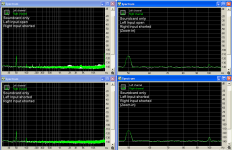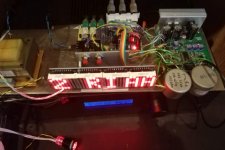Looks good, does not appear to support ASIO.
This thread reminds me, I did a lot of this a while back. I'm almost famous for audio restoration! I contributed two tracks ("restorations" of the original) to this CD compilation:
PME Records Audio Restoration Comparison CD
I still use my paid-and-registered copy, though on modern Windows I have to right-click, run-as-Administrator for it to recognize that it's a paid-for copy with all the features available instead of the crippled share/begware version.
PME Records Audio Restoration Comparison CD
I recall the history, I registered CE 2000 just before Adobe bought out Cool Edit in 2003. Adobe almost immediately dropped the two track editor (2000) and continued development on the multitrack recorder (Cool Edit Pro, renamed Adobe Audition). Dunno what the legal status is, Adobe likely still owns the copyright, but I suppose for practical purposes it's abandonware.The status of CoolEdit 2000 is in limbo, it's not clear anymore that anyone cares if you download it from a piracy site.
I still use my paid-and-registered copy, though on modern Windows I have to right-click, run-as-Administrator for it to recognize that it's a paid-for copy with all the features available instead of the crippled share/begware version.
The status of CoolEdit 2000 is in limbo, it's not clear anymore that anyone cares if you download it from a piracy site. I can't get my copy to record from a USB device and really get 24 bits anymore anyway. A few folks got surprised by this, examination of the actual data showed 8 trailing zeros. Same with Audacity in many(all?) cases for different reasons. None of the devices or the software reports any errors.
Verbatim zeros or at least 8 times the sign bit?
That would nearly cost the LSB.
regards, Gerhard
As the front end will be an instrumentational amplifier (INA), there is no point to fit it at the headshell (I am experimenting with an AD620, I’ll report soon).
Although the construction of this INA isn’t that symmetric (*) and doesn’t do justice to the AD620 CMRR, from the initial testings with an MI cartridge (AKG P8ES R=1050 Ohm, L=280mH), it is evident that a balanced input has noise advantage the more cartridge to preamplifier cable length increases
George
(*)
http://www.diyaudio.com/forums/equi...menting-y-out-oscilloscope-8.html#post2622342
http://www.diyaudio.com/forums/equi...menting-y-out-oscilloscope-9.html#post2634095
http://www.diyaudio.com/forums/equi...enting-y-out-oscilloscope-10.html#post2634909
Attachments
Interesting will take a listen. I assume people have tried some of Monty78pig's efforts he posts on soundcloud? I am hoping that this thread will meander around quite a few of the restoration techniques available. I am partial to some of the re-releases on the Dutton label, mostly from the master tapes, but with superb results. But I have read that some view his methods as too heavy handed and over restoring.This thread reminds me, I did a lot of this a while back. I'm almost famous for audio restoration! I contributed two tracks ("restorations" of the original) to this CD compilation:
PME Records Audio Restoration Comparison CD
Verbatim zeros or at least 8 times the sign bit?
That would nearly cost the LSB.
regards, Gerhard
Sorry my bad, how about the codes all rest on 16 bit values or the histogram has only 65536 bins.
Good test for Google's Assistant? Not interesting to listen to however.
I have about 1,200 LP's. Now in my senescence, if either the performance isn't great or the recording is short, I take them to "Habitat" which is better than the garbage can.
The differential input has more 50Hz noise, but lower HF noise?.... it is evident that a balanced input has noise advantage the more cartridge to preamplifier cable length increases
Keep in mind that the CD at the link I posted was done about 13 years ago, and there's surely been good advancement in restoration software since then. Also, 78s are a different animal from LP's. There's the "occasional" click on LPs, but 78s are made with abrasive bits of stuff to intentionally wear down a steel needle (in an acoustic record player) , apparently so that it will keep the shape of the groove and give "decent" reproduction. This gives the constant crackling sound on 78s, which (despite my use of the "wrong" software for that CD) requires different methods to (try to) reduce it.Interesting will take a listen. I assume people have tried some of Monty78pig's efforts he posts on soundcloud? I am hoping that this thread will meander around quite a few of the restoration techniques available. I am partial to some of the re-releases on the Dutton label, mostly from the master tapes, but with superb results. But I have read that some view his methods as too heavy handed and over restoring.
Here is a thought- clicks will always have the same relationship to the audio but is surface noise random or is it always the same with each play? Could we use some coherent multiplication to separate the music from the noise? Play the disk 2-4 times and let the software do its magic? Is this overkill?
This would not work with an outboard box.
This would not work with an outboard box.
http://www.diyaudio.com/forums/anal...i-want-know-all-approaches-4.html#post4856513
Not to poo-poo your idea Demian, but that seems fraught with temporal tracking issues.
Not to poo-poo your idea Demian, but that seems fraught with temporal tracking issues.
The differential input has more 50Hz noise, but lower HF noise?
Michael,
With the AKG across the 133cm wire in differential mode it seems that 50Hz has peaked (*). Also note that the 50Hz spike is more or less an artifact of the sound card, see attachment below.
My bad. I forgot to note in the previous post that the measuring channel of the sound card was the Left channel (white trace). The Right channel (green trace) was shorted at the input..
George
(*) And as the measurements were done one at a time, I can not rule out that the 50Hz peak increase was due to an environmental interference.
If it was an environmental momentary issue, the cartridge would pick it up too and what the cart picks up, it shows as differential signal and not as common mode signal, thus the amplification.
I have to do the 10cm and the 133cm runs again with a 1kOhm resistor in place of the AKG cartridge, for to take the cartridge pick-up of the magnetic field out of the picture and leave only the wire pick-up show on the FFTs
George
Attachments
ESS made two ADCs (ES9102 & ES9112) that had RIAA filter @48kHz built in but they are out of production now because of bugs with custom filter manipulation. Anyway, I got ES9102 by a kind donation of one DIYA member and made an ADC with simple opamp line prepreamp for phono cartridge. It works very well for my needs; I didn't use analog preamp anymore so I couldn't listen to my old LP collection. Now I have choice of either phono preamp + line ADC or line prepre + riaa ADC. It's still missing the housing, but already it has no audible noise or hum. 🙂 Maybe will ESS reintroduce ADCs to the production?
Attachments
Last edited:
Thanks vuki.
Any info on which outcome from the two you prefer and why?
George
Not yet. I'm using simple ad797 based mm pre & beyerdinamic stepup for mc. I have two turntables - Thorens TD124/Decca International/Denon DL103 and Technics SL7/Ortofon 320. I also have one 3yo. running around so not much time for real comparation and listening test (or even listening).

vuki
Give all your time to your kid and you will never regret it.
Leave the listening for when you’ll get old.
This too you won’t regret, because by then you won’t hear the highs and all will sound good to you 😀
The tech info on these two ADCs look impressive. These would be ideal for the task
ES9102 pdf, ES9102 description, ES9102 datasheets, ES9102 view ::: ALLDATASHEET :::
George
Give all your time to your kid and you will never regret it.
Leave the listening for when you’ll get old.
This too you won’t regret, because by then you won’t hear the highs and all will sound good to you 😀
The tech info on these two ADCs look impressive. These would be ideal for the task
ES9102 pdf, ES9102 description, ES9102 datasheets, ES9102 view ::: ALLDATASHEET :::
George
Following Scott's comments on Mr Obert-Thorn I of course has to discuss this with another music loving friend, which ended up with me finding this https://www.pristineclassical.com/pasc422.html
Now that is dedication and madness in equal measure.
Now that is dedication and madness in equal measure.
I could not get even OK performance from the ESS demo boards.vuki
Give all your time to your kid and you will never regret it.
Leave the listening for when you’ll get old.
This too you won’t regret it because by then you won’t hear the highs and all will sound good to you 😀
The tech info on these two ADCs look impressive. These would be ideal for the task
ES9102 pdf, ES9102 description, ES9102 datasheets, ES9102 view ::: ALLDATASHEET :::
George
Sent from my LG-H811 using Tapatalk
- Status
- Not open for further replies.
- Home
- Source & Line
- Analogue Source
- Digitizing vinyl



